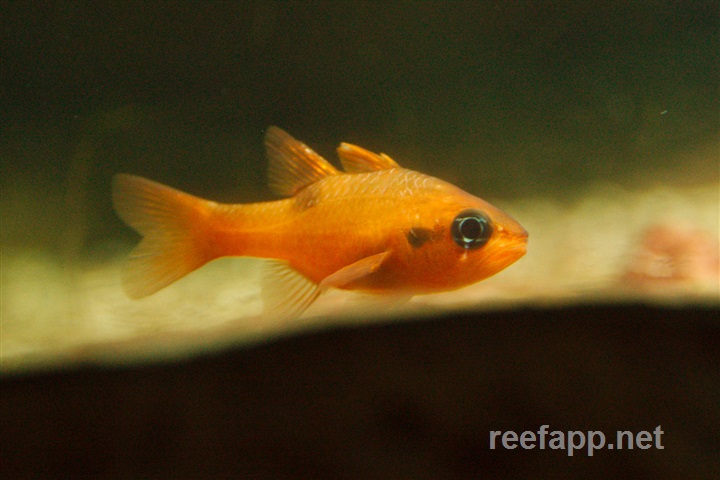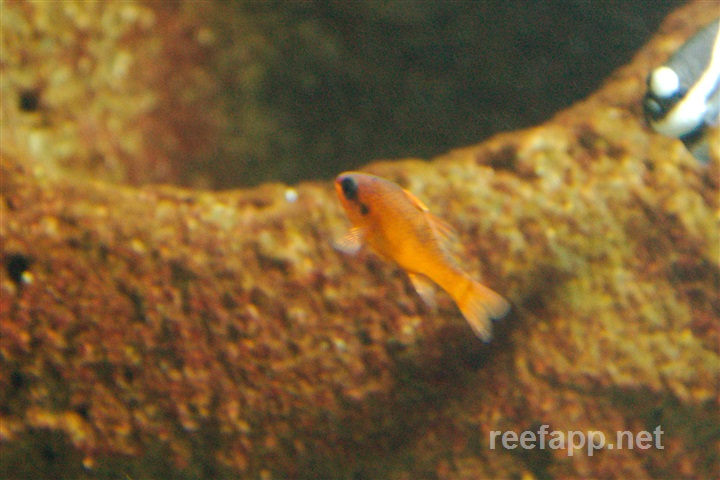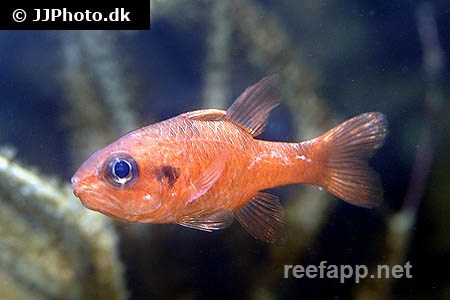Apogon maculatus



| Latin name | Apogon maculatus - (Poey, 1860) |
|---|---|
| Local name | Flame Cardinal |
| Family | Apogonidae - Apogon |
| Origin | The Mexican Golf, West Atlantic |
| Max length | 11 cm (4.3") |
| Minimum volume |
150 l (40 gal) |
|---|---|
| Hardiness |
Delicate |
| Suitable for aquarium |
Suitable for most aquarium |
| Reef safe |
Always reef safe |
| Aggressiveness | Aggressive towards similar species |
| Recommended |
Small crustaceans (Krill, mysis, artemia...) Zooplankton (Cyclops, pods...) |
|---|---|
| Maybee |
Larger crustaceans (Shrimp, crabs...) |
This species can be a threat towards small crustaceans, e.g. small shrimp.
In captivity this species will attempt to make its own little territory. It can therefore be very aggressive towards species of the same family, when not provided with sufficient space.
These fish flourish better without other members of the same species in the aquarium.
This species is very sensitive during transportation and acclimatizing into the aquarium.
In the aquarium the colour of this species can become matte.
Food with plenty of pigment and generally a varied diet of high quality can help alleviate colour loss.
This species needs good hiding places, for example, between live rocks.
This species is nocturnal and therefore the most active when the light is dimmed or turned off.
A. pseudomaculatus resembles this species closely, but A. maculatus has a spot behind its eye, but not at the caudal peduncle.
Cardinalfish come in many different shapes and colours, generally they are well suited for aquaria.
Cardinalfish have a large mouth and a big appetite, take this into account with feeding the other fish. These fish typically live off of Artemia, Mysis and krill. In the aquarium they will eat anything they can.
They will sometimes eat small shrimps and fish, so do be aware of this, but it is not normally a problem.
It is possible to keep several species together, if space allows. Some species will form small shoals. They are normally peaceful towards other fish, but will sometimes fight among themselves if there isn't sufficient space or food.
Many species are nocturnal and will therefore often seek a hiding place during the day. This can be between stones, SPS corals and, in some cases, in an anemone and between spines of Sea urchins.
Cardinalfish are a good choice if ones wishes to attempt to start a breeding tank.
| Aquarium trade | Yes |
|---|---|
| Distribution | Western Atlantic: Canada (Ref. 5951) to Massachusetts (USA), Bermuda, Bahamas, and Gulf of Mexico (Ref. 26340) to Brazil. |
| English common names |
Flamefish |
Scott W. Michael. 2001. Basslets, Dottybacks & Hawkfishes: v. 2 (Reef Fishes) - TFH Publications / Microcosm Ltd. - (English)
Bob Fenner. Cardinalfishes, Family Apogonidae, Pt. 1, Pt. 2 - Wet Web Media - (English)

